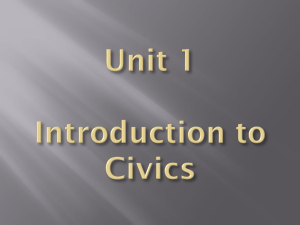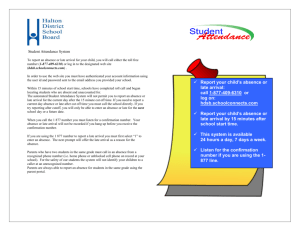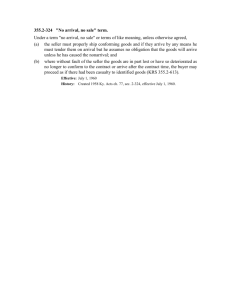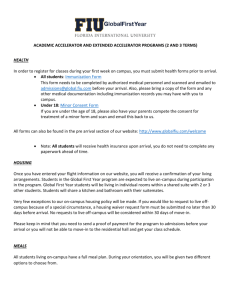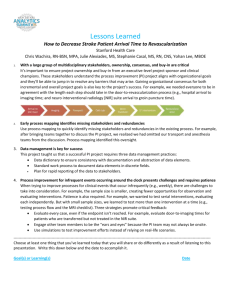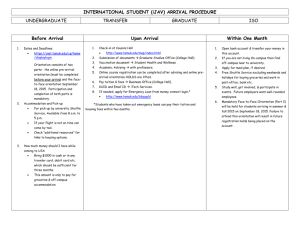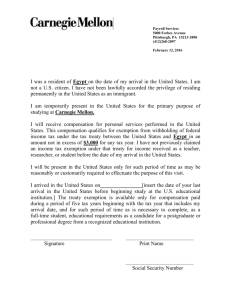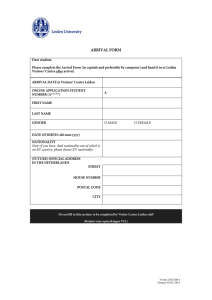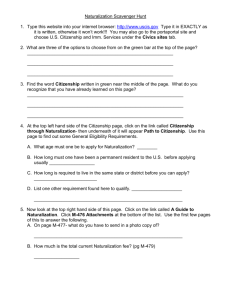Year of Entry
advertisement
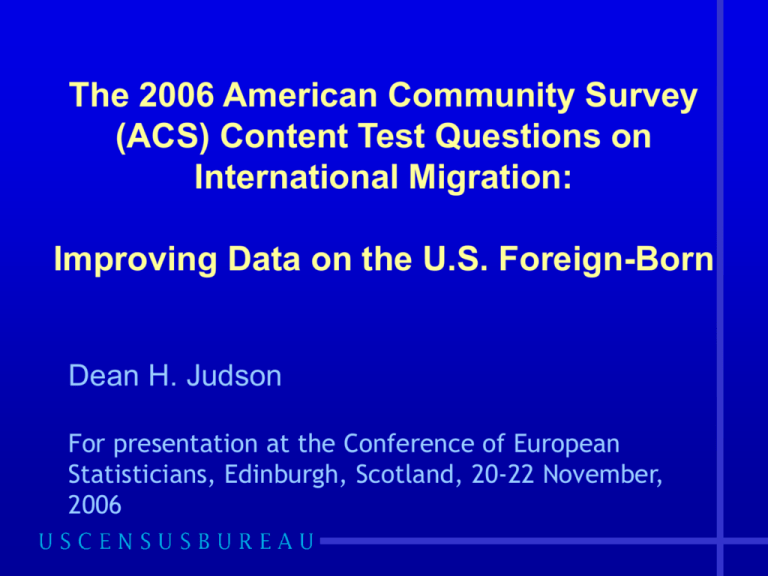
The 2006 American Community Survey (ACS) Content Test Questions on International Migration: Improving Data on the U.S. Foreign-Born Dean H. Judson For presentation at the Conference of European Statisticians, Edinburgh, Scotland, 20-22 November, 2006 CES Recommendations for 2010 Censuses: Migration Section “To facilitate and improve the comparability of data at a regional level through the selection of a core set of census topics and the harmonization of definitions and classifications.” 2 Issues with U.S. Census Bureau International Migration Data • Difficult to obtain accurate distributions of the foreign born by U.S. citizenship status (citizen versus non-citizen) • Difficult to estimate time spent in the United States by the foreign born 3 Opportunities for Improvement: The American Community Survey • An ongoing nationwide survey that collects socioeconomic and housing information and • replaces the long form component of the 2010 census 4 Opportunities for Improvement: The ACS Content Test • 63,000 housing units • Two versions of question content 1) a control version and 2) a variant, or test, version 3) Followup tested consistency of responses • Changes that met data quality criteria will be implemented in the 2008 ACS, and reflected in the 2009 data release. 5 Improving Data on International Migration: Questions on the ACS • U.S. Citizenship Status • Year of Entry Related but Not Discussed Here. . . • Place of Birth • Residence One Year Ago 6 Motivation for Changes: Citizenship Status • Naturalization: appears to be over-reported in some Census & survey data (Passel and Clark, 1997) • Year of Naturalization: -item would help to reduce reports of naturalization by non-citizens (by prompting them to examine their answer) -Year naturalized could be compared with year first entered to determine if respondent had been in country long enough to naturalize 7 Motivation for Changes: Year of Entry • Current question does not account for multiple entries (Redstone and Massey, 2004) • Will better approximate host country experience by asking for first & most recent entry 8 Content Test Questions: Citizenship Control Variant 9 Content Test Questions: Year of Entry Control Variant 10 Summary of Question Changes Control version: Test version: Citizenship -five categories, including “Naturalized Citizen” Citizenship -five categories, including “Naturalized Citizen” and write-in for year naturalized -American parent(s) -U.S. Citizen Parents Year of Entry -Allows for reporting one entry Year of Entry -Allows for reporting more than one entry (first and most recent) 11 Selection Criteria: U.S. Citizenship Status • The percent naturalized in the test version will be equal to or less than the percent for the control. • The percent of non-responses in the test will be equal to or less than the percent for the control. 12 Citizenship Status: Naturalized Citizens 25 Percent 20 15 Test Control 10 5 5.1 5.2 0 Citizen by naturalization Universe: All nonblank records 13 Citizenship Status Nonresponse Rates 25.0 Percent 20.0 15.0 Test Control 10.0 9.8 5.0 0.0 2.7 3.0 1 Citizenship Status 2 Year of Naturalization 1: Universe includes all nonblank records 2: Universe includes all test records of naturalized citizens 14 Summary: Citizenship Status Percent Naturalized (Control versus Test) No statistical difference Item Non-response: -Citizenship Status (Control versus Test) No statistical difference -Year of Naturalization Ten percent non-response for those naturalized Conclusion: Asking for year naturalized had no statistically significant effect on Citizenship item but does have other uses 15 Selection Criteria: Year of Entry • The net difference rate will be lower in the test version than the control (by period of entry). • The percent of non-responses for the test version will be equal to or less than the percent for the control. (for information purposes only. . .) • Determine if the year of entry values provided in the control version reflect a first year of arrival, most recent year of arrival, or something else. 16 Number of Arrivals: Test versus Follow-up 100 47.7 (4.6) Percent 80 47.7 (4.6) 87.2 60 Test 60.6 Followup 40 39.4 20 12.8 0 Once More Than Once Universe: Test cases of population born outside the U.S. 17 Year Entered: Control and Test versus Follow-Up (Year entered matches exactly) 100 Percent 80 60 68.0 70.3 74.0 63.5 66.1 63.5 65.7 60.2 Test (only or most recent arrival) Control 40 20 0 2000 or later 1990 to 1999 1980 to 1989 Before 1980 Universe: All persons born outside the United States. 18 Year Entered: Control and Test versus Follow-Up (Year entered matches within two years) 100 94.1 80 Percent 80.5 90.0 83.7 84.1 84.1 87.7 84.7 60 Test (only or most recent arrival) Control 40 20 0 2000 or later 1990 to 1999 1980 to 1989 Before 1980 Universe: All persons born outside the United States. 19 Year of Entry Nonresponse Rates Universe: Population born outside the United States 100 Percent 80 83.3 60 Test Control 40 20 23.1 21.7 22.6 0 Year of First/Only Arrive Year of FirstArrival or1 Arrivemore More than or Year of Entry than once? 1 Only Arrival Once? Year ofof Most Year Most Recent Arrival 2 Recent Arrival 1: Includes all nonblank records. 2: Includes all test cases that marked more than one entry. 20 Years Entered for Persons with Multiple Entries: Follow-up Interviews with Control Group to Check for Consistency of Year Provided 50 Same Decade Year to Year 45 44.6 40 Percent 35 32.6 30 30.6 25 25.1 20 15 21.3 18.8 18.0 10 Matches Decade/Period of Last Arrival Matches Decade/Period of First Arrival Matches Both No Match Matches Year of Last Arrival Matches Year of First Arrival Matches Both 0 No Match 9.1 5 Universe: All control records indicating more than one arrival in reinterview. 21 Summary: Year of Entry Item Consistency Number of Entries (Test versus Follow-Up): Large difference (48 percentage points) in proportion of respondents indicating single versus multiple entries. Year Entered (Control and Test versus Follow-up): Somewhat consistent reporting of exact year and good reporting within two years. Year Entered (Control vs. Follow-up, Multiple Entries): Follow-up reporting indicated that the original response more often represented the first year of arrival than the most recent year of arrival. However, exact year matches and same decade reporting was poor, with a sizeable proportion matching neither first nor last arrival. 22 Summary: Year of Entry (Cont.) Item Non-response Year Entered (Control versus Test): • Only or first arrival -No statistical difference -non-response somewhat high for both versions (22 percent). • Year of most recent arrival -very high non-response (83 percent) Conclusion The control version performed better, although follow-up interviewing suggested concerns for the control. 23 Thoughts on lessons learned • • The purpose was to better represent the hard-toenumerate foreign born Year of naturalization has analytic value – – – • Did no harm to the overall question Can be used for consistency checking Appears to be well understood Year of arrival – – – Despite successful cognitive testing… Question form continues to be problematic Many inconsistent responses 24
